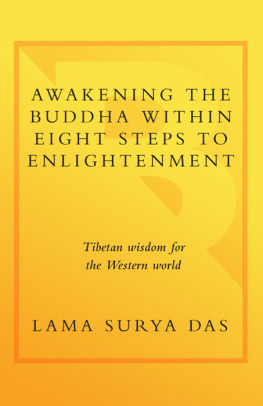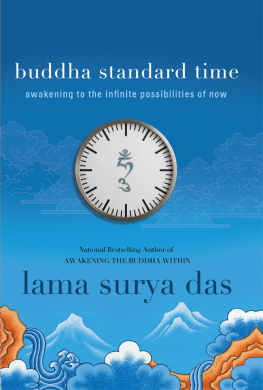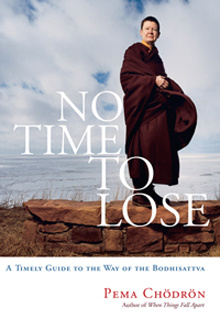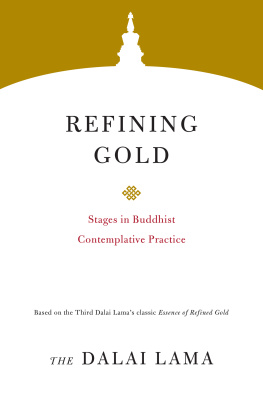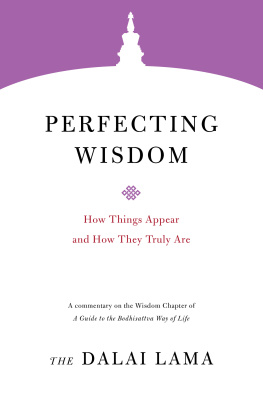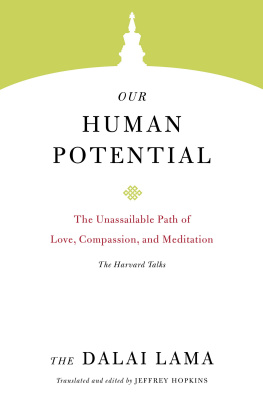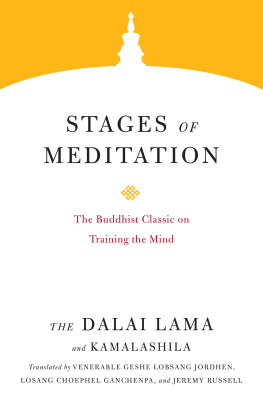
The whole universe is my body, all beings my mind.
From The Vajrayogini Tantra
Contents
Preface
Make Me One with Everything
W hat did the Dalai Lama say to the hot dog vendor?
Make me one with everything.
Its a jokeand a pretty good onebut theres more to it than that. Becoming one with everything by seeing through separateness and solidity is the heart of what I call inter-meditation. Inter-meditation means meditating withthe practice and art of intimacy and union with whatever is, just as it is. It is the yoga of convergence, connection, co-meditation, and spontaneous oneness. Its a path we can take to overcome our illusions of duality.
A recent encounter with a Tibetan Buddhist teacher illustrated to me the incredible value of inter-meditation in our disconnected, plugged in yet tuned-out times. I was at a retreat in Carmel, California, with Tibetan master Anam Thubten Rinpoche. During one of his talks, a woman in the audience asked him a searing question: What should I do with the great fear I experience? For several months, she had noticed that the medication for her bipolar disorder was no longer effective. Her doctors confirmed that this was the case and that Western medicine likely had nothing more to offer her. She had been in therapy on and off for many years, and more recently had tried all manner of alternative approaches, but her mood swings were increasing in frequency as well as becoming more intense.
The woman spoke to Rinpoche about her terrible uncertainty for her sanity, and after a few words he invited her to come close and sit facing him. By the time she had shared all she needed to, her eyes were full of tears. Rinpoche remained silent for a minute or two, and then he quietly said, Your suffering is mine. Your fear is mine. Many of us gasped at the exquisite beauty of his response. And there were tears in his eyes as well as he added, You are not alone.
The woman and Rinpoche meditated together for a few more minutes and then he asked, What do you feel?
Love. Great love, but after all, its you.
He replied, No, the love is youyour seeing and knowing whats inside of you.
For me, their exchange beautifully represents what it means to be in the present moment, connecting to another and allowing all-encompassing compassion and surrender to flow back and forth with no boundariesinter-meditation. My Buddhist Dzogchen lineage would call this the Natural Great Perfection in action. It is a living example of healing and awakening together, and shows us that love does not come from outside of us, not really. Love comes from loving. Love is self-perpetuating. Love is a verb. Infinite love is both enlightenment and our birthright.
One of my most powerful encounters with inter-meditation occurred during the 1980s, when I lived for three and a half years in cloistered retreat at the Nyingmapa Tibetan center in the forest of Dordogne, France. My fellow students and I spent most of our days in individual monastic cells, where we meditated and maintained silence at all times except when we gathered for chanting, liturgical rituals, and teachings before breakfast and at dusk. One afternoon, our beloved teacher, Lama Nyoshul Khenpo Rinpoche, summoned all twenty-three of us to the hermitages meditation hall for a lesson.
Typically we sat on cushions in parallel rows like warmhearted ice cubes lined up in a tray, but on this occasion Khenpo Rinpoche asked us to sit knee-to-knee, very close together, almost overlapping as we chanted in unison.
See how that is... and feels... Notice intently how it goes, he instructed.
This was no small challenge. Imagine, after months of celibacy and solitude, a group of monks and nunsall friends and comradessuddenly sitting in such intimate proximity, with nowhere to run and hide, no opportunity to employ personality tricks or defense mechanisms or holier-than-thou airs, no way to avoid the presence of the people in front of and around us. Any and all of our movements were exposed, as if we were naked and vulnerable, in kinship with all.
Time passed in a far more agonizing fashion than when Id sat in solitude waiting for the gong to signal the end of the meditation period, and far more slowly than any time Id watched a teakettle and waited for the water to boil, or looked forward to a holiday that was months away. The seconds and minutes ticked by in pure, clear silence. I could only hear the sound of breathing and my pulse beating so thunderously that I was convinced that everyone else could hear it, too.
I have no idea how much time went by. Time is plastic, malleable, subject to the vagaries of mind and body, energy, and space. At last our venerable meditation master said, Now close your eyes, and tune in. Pay attention. Listen. Feel. Intuit. Observe sensations in the body and whatever momentarily arises in the field of consciousness. Let go and relax, and let be. As it is. Nothing more to do, understand, or accomplish. Not meditating, not manipulating or altering, not interfering or fabricating anything. Just breathing and awareness, open, spacious, relaxed, and clear.
We sat like that for a while. Stillness reigned, except of course in my head. I fretted about samsarathe ordinary worldly realm of conditioned existence, suffering, and confusion. What was causing my feelings of existential angst and imprisonment when I was merely sitting still and had no other problems or responsibilities? My wild, untamed, distracted monkey-mind!
Then Khenpo Rinpoche asked us to open our eyes and continue to meditate. I became intensely aware that a wonderful woman was touching one of my knees, or should I say that I was touching hers? (With my consciousness, that is, as well as my knee.) This contact inspired further thoughts and fantasiesI just couldnt silence that monkey-mind.
Khenpo Rinpoche broke my reverie by saying, Now close your eyes again, and start breathing together, in sync. In-breath... out-breath. Inhaling slowly, exhaling slowly. Not deep breathing or breath retention, just natural, normal in-breath... out-breath. He didnt want us to give the in-breath any more attention or weight than the out-breaththey were the same. In-breath... out-breath. Observe the gentle wind, the settling tides of ordinary breath. Observe, vigilantly. Pay attention with careful alert presence of mind. Allow clarity to emerge from within.
So I inhaled and exhaled and inhaled and my breath took on a lovely rhythm, like a gentle waltz. In-breath, out-breath, with nothing in betweenflow. Gradually I noticed we were all breathing together effortlessly, naturally, as a group and almost in unison. Palpable energy emanated from my solar plexus, out and in, radially, as if expanding and contracting on the subtle pranic, or energetic, level. It felt as if I were a cosmic balloon or bellows operated by powers beyond myself, perhaps Higher Powers, perhaps deeper. I felt infinitely large and full, then infinitely small and deflated. My bifurcating mind and discursive conceptual thinking blended into what was, just as it was.
Everything, including time and mind, seemed to stop. I was limitless. The sacred space of the meditation room seemed far greater inside than outside. Was this the legendary crystal cathedral of the shining Void? The divine candle in a hidden niche of the pearl mosque of which the mystics sing?
At some point, with a few pithy instructions, Khenpo Rinpoche guided us deeper and further into contemplation, incandescent presence, bliss, and spacious clarity. All separate parts mergedlike mother and childin the light of reality, groundless and boundless. He urged, Enjoy the natural state of pure being, incandescence, now-nessor whatever state you think youre in. This will have to do.
Next page

